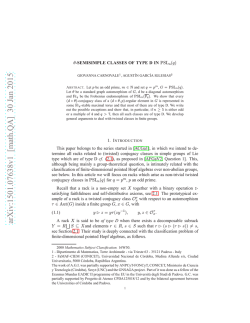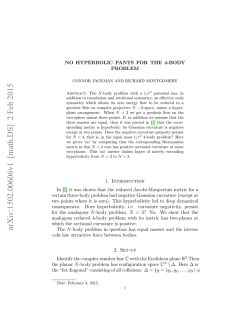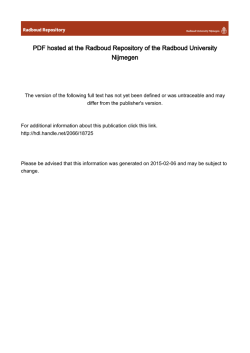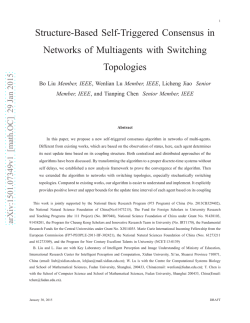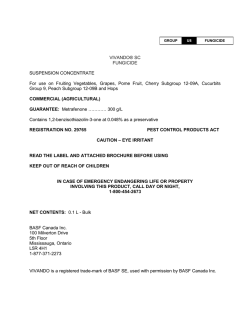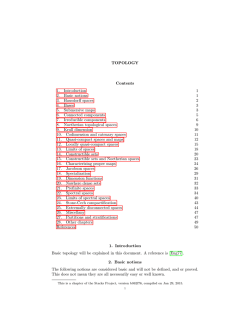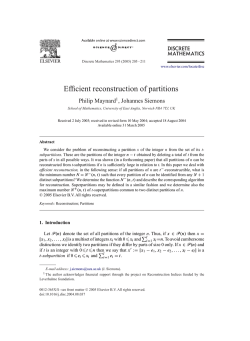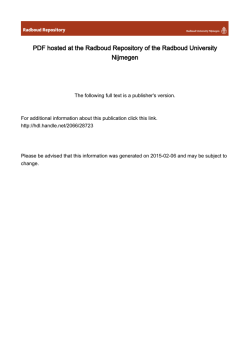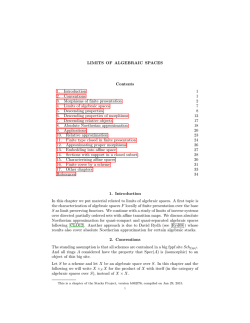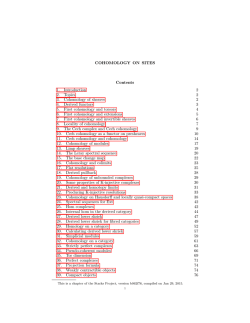
documento 492540
arXiv:1501.07694v1 [math.GT] 30 Jan 2015
THE FIXED SUBGROUPS OF HOMEOMORPHISMS OF SEIFERT
MANIFOLDS
QIANG ZHANG
Abstract. Let M be a compact connected orientable Seifert manifold with hyperbolic orbifold BM , and fπ : π1 (M ) → π1 (M ) be an automorphism induced by an orientation-reversing
homeomorphism f of M . We give a bound on the rank of the fixed subgroup of fπ , namely,
rankFix(fπ ) < 2rankπ1 (M ), which is similar to the inequalities on surface groups and hyperbolic
3-manifold groups.
1. Introduction
For a group G and an endomorphism φ : G → G, the f ixed subgroup of φ is
Fix(φ) := {g ∈ G|φ(g) = g},
which is a subgroup of G. Let rankG denote the rank of G, which means the minimal number of
the generators of G.
For a free group F and an automorphism φ, M. Bestvina and M. Handel [BH] solved the Scott
conjecture:
Theorem 1.1 (Bestvina-Handel). Let F be a free group and φ be an automorphism of F . Then
rankFix(φ) ≤ rankF.
In the paper by B. Jiang, S. Wang and Q. Zhang [JWZ], it is proved that
Theorem 1.2 (Jiang-Wang-Zhang). Let S be a compact surface and φ be an endomorphism of
π1 (S). Then
rankFix(φ) ≤ rankπ1 (S).
In a recent paper [WZ], J. Wu and Q. Zhang generalized Theorem 1.2 to a family endomorphisms
of a surface group. In [LW] (see [Z2] for an enhance version), J. Lin and S. Wang showed that
Theorem 1.3 (Lin-Wang). Let M be a compact orientable hyperbolic 3-manifold with finite volume
and φ be an automorphism of π1 (M ). Then
rankFix(φ) < 2rankπ1 (M ).
In this paper, we consider the fixed subgroups of automorphisms of Seifert 3-manifold groups.
Suppose M is a compact orientable 3-manifold. We say that M is a Seif ert manif old, if M
possesses a Seif ert f ibration which is a decomposition of M into disjoint simple closed curves,
called f ibers, such that each fiber has a solid torus neighborhood consisting of a union of fibers.
Identifying each fiber of M to a point, we get a set BM , called the orbif old of M , which has a
natural 2-orbifold structure with singular points consisting of cone points. It is useful to think of
a Seifert manifold as a circle bundle over a 2-orbifold. For brevity, we say an orbifold it means a
compact 2-orbifold with singular points consisting of cone points in the following. An orbifold (or
1991 Mathematics Subject Classification. 57M05, 57M07, 37C25.
Key words and phrases. Seifert manifolds, fixed subgroups, homeomorphisms, ranks.
1
2
QIANG ZHANG
surface) is called hyperbolic if it has negative Euler characteristics. A hyperbolic orbifold is orbifold
covered by a hyperbolic surface and admits a hyperbolic structure with totally geodesic boundary.
For more information about orbifolds, see [JWW, §1 and §2] and [S, §2]. A map f on a Seifert
manifold M is called f iber-preserving if it maps fibers to fibers. If f is fiber-preserving, then it
induces a map f ′ : BM → BM on the orbifold BM .
In the following, all spaces are assumed to be connected and compact unless it is specially stated
otherwise. For a set X, let #X denote the number of points in X.
The main result of this paper is
Theorem 1.4. Suppose M is a compact connected orientable Seifert manifold (closed or with
toroidal boundary) with hyperbolic orbifold BM , and fπ : π1 (M ) → π1 (M ) is an automorphism
induced by an orientation-reversing homeomorphism f : M → M . Then
rankFix(fπ ) < 2rankπ1 (M ).
Remark 1.5. By the well known Geometrization Theorem, M is a Seifert manifold with hyperbolic
orbifold BM if and only if M admits a geometric structure based on one of the two geometries :
H2 × R, SL(2, R). The condition that f is orientation-reversing is necessary. If f is orientationpreserving, then the fixed subgroup Fix(fπ ) can be infinitely generated, see [Z1, Example 5.2].
Remark 1.6. By [Z1, Example 5.1], one can show that there is an orientation-reversing homeomorphism f of Mn = Sn × S 1 , where Sn is a closed orientable surface of genus n ≥ 2, such
that rankFix(fπ ) = 4n − 2. Therefore, for any ε > 0, there exists a Seifert manifold Mn and an
orientation-reversing homeomorphism f of Mn , such that
rankFix(fπ )
4n − 2
=
> 2 − ε.
rankπ1 (Mn )
2n + 1
Theorem 1.4 is inspired by the following proposition [Z1, Corollary 1.4].
Proposition 1.7. Suppose f : M → M is a homeomorphism of a compact connected orientable
Seifert manifold with hyperbolic orbifold BM . Let f∗ : π1 (M, x) → π1 (M, x) be the induced automorphism, where x is a fixed point contained in an essential fixed point class of f . Then
rankFix(f∗ ) < 2rankπ1 (M ).
The paper is organized as follows. In Section 2, we will give some background on fixed points
and fixed subgroups of a selfmap. In Section 3, we will give some useful facts on Fuchsian groups.
In Section 4, we will consider the special case of Theorem 1.4 that M is an orientable circle bundle
over an orientable hyperbolic surface. Finally, we will finish the proof of Theorem 1.4 in Section 5,
and give some examples and questions in Section 6.
Acknowledgements. The author would like to thank Professor Boju Jiang for valuable communications. This work was carried out while the author was visiting Princeton University and he would
like to thank for their hospitality. The author is partially supported by NSFC (No. 11201364) and
“the Fundamental Research Funds for the Central Universities”.
2. Fixed points and fixed subgroups
Let X be a connected compact polyhedron and f : X → X be a selfmap. In this section, we
introduce some facts on fixed point classes and fixed subgroups of f .
The fixed point set
Fixf := {x ∈ X|f (x) = x}
THE FIXED SUBGROUPS OF HOMEOMORPHISMS OF SEIFERT MANIFOLDS
3
splits into a disjoint union of f ixed point classes: two fixed points are in the same class if and
only if they can be joined by a N ielsen path, which is a path homotopic (rel. endpoints) to its
own f -image. For each fixed point class F, a homotopy invariant index ind(f, F) ∈ Z is defined.
A fixed point class is essential if its index is non-zero, otherwise, called inessential (see [J] for an
introduction).
Although there are several approaches to define fixed point classes, we state the one using paths
and introduce another homotopy invariant rank rank(f, F) ∈ Z for each fixed point class F (see
[JWZ, §2]), which plays a key role in this paper.
Definition 2.1. By an f -route we mean a homotopy class (rel. endpoints) of path w : I → X from
a point x ∈ X to f (x). For brevity we shall often say the path w (in place of the path class [w]) is
an f -route at x = w(0). An f -route w gives rise to an endomorphism
fw : π1 (X, x) → π1 (X, x), [a] → [w(f
◦
a)w]
where a is any loop based at x, and w denotes the reverse of w. For brevity, we will write
fπ : π1 (X) → π1 (X)
when w and the base point x are omitted.
Two f -routes [w] and [w′ ] are conjugate if there is a path q : I → X from x = w(0) to x′ = w′ (0)
such that [w′ ] = [qw(f ◦ q)], that is w′ and qw(f ◦ q) homotopic rel. endpoints. We also say that
the (possibly tightened) f -route qw(f ◦ q) is obtained from w by an f -route move along the path q.
Note that a constant f -route w corresponds to a fixed point x = w(0) = w(1) of f , and the
endomorphism fw becomes the usual
f∗ : π1 (X, x) → π1 (X, x), [a] → [f
◦
a],
where a is any loop based at x. Two constant f -routes are conjugate if and only if the corresponding
fixed points can be joint by a Nielsen path. This gives the following definition.
Definition 2.2. With an f -route w (more precisely, with its conjugacy class) we associate a f ixed
point class Fw of f , which consists of the fixed points that correspond to constant f -routes conjugate
to w. Thus fixed point classes are associated bijectively with conjugacy classes of f -routes. A fixed
point class Fw can be empty if there is no constant f -route conjugate to w. Empty fixed point
classes are inessential and distinguished by their associated route conjugacy classes.
Definition 2.3. The f ixed subgroup of the endomorphism fw is the subgroup
Fix(fw ) := {γ ∈ π1 (X, w(0))|fw (γ) = γ}.
The stabilizer of the fixed point class Fw is defined to be
Stab(f, Fw ) := Fix(fw ),
it is well defined up to isomorphism because conjugate f -routes have isomorphic stabilizers. Hence,
we have the rank of Fw defined as
rank(f, Fw ) := rankStab(f, Fw ) = rankFix(fw ).
The following are some facts on stabilizer (see [JWZ, §2]).
Fact (Homotopy invariance). A homotopy H = {ht }t∈I : X → X gives rise to a bijective
correspondence H : Fw0 → Fw1 from h0 -fixed point classes to h1 -fixed point classes, and
ind(h0 , Fw ) = ind(h1 , Fw ), Stab(h0 , Fw ) ∼
= Stab(h1 , Fw ),
0
1
0
1
which indicates that the index ind(f, Fw ) and the rank rank(f, Fw ) of a fixed point class are both
homotopy invariants.
4
QIANG ZHANG
Fact (Morphism). A morphism from a selfmap f : X → X to a selfmap g : Y → Y means a
map h : X → Y such that h ◦ f = g ◦ h. It induces a natural function w → h ◦ w from f -routes to
g-routes and a function Fw → Fh◦w from f -fixed point classes to g-fixed point classes, such that
h(Fw ) ⊆ Fh◦w , h∗ Stab(f, Fw ) ≤ Stab(g, Fh◦w ).
The following are useful lemmas on covering spaces and fixed point classes.
Lemma 2.4. Let p : M → M be a finite covering of a compact manifold M , and f : M → M be a
homeomorphism. Suppose f˜ : M → M is a lifting of f , and the f˜-route w
˜ is a lifting of the f -route
w. Then the f -fixed point class Fw associated to w is essential if and only if the f˜-fixed point class
Fw˜ associated to w
˜ is essential, moreover,
ind(f˜, Fw˜ ) = n × ind(f, Fw )
where n is a positive integer.
Proof. Since indices of fixed point classes are homotopy invariants of the map f , via perturbation,
we may assume that all fixed points of f are isolated.
Firstly, we claim that Fw˜ is nonempty if and only if Fw is nonempty, and p(Fw˜ ) = Fw .
If Fw˜ is nonempty, then for any point x˜ ∈ Fw˜ ⊆ Fixf˜, the f˜-route w
˜ is conjugate to x˜, namely,
˜ f˜ ◦ γ) ≃ x
˜ rel. x˜. Hence
there is a path γ : I → M from w(0)
˜
to x
˜ such that γ w(
(p ◦ γ)w(f (p ◦ γ)) = p(γ w(
˜ f˜ ◦ γ)) ≃ p(˜
x).
Namely, the f -route w is conjugate to the point p(˜
x) ∈ Fw ⊆ Fixf . So p(Fw˜ ) ⊆ Fw .
If Fw is nonempty, then for any point x ∈ Fw ⊆ Fixf , the f -route w is conjugate to x, namely,
there is a path c from w(0) to x such that cw(f ◦ c) ≃ x rel. x. Let c˜ be a lifting of c from
w(0)
˜
to a point x
˜ ∈ p−1 (x). Then c˜w(
˜ f˜ ◦ c˜) is a lifting of the contractible loop cw(f ◦ c). Hence
˜
c˜w(
˜ f ◦ c˜) is also a contractible loop and f˜(˜
x) = x
˜, namely, the f˜-route w
˜ is conjugate to the point
x
˜ ∈ Fw˜ ⊆ Fixf˜. So Fw ⊆ p(Fw˜ ) and the claim holds.
Secondly, we prove ind(f˜, Fw˜ ) = n × ind(f, Fw ).
If Fw is empty, then Fw˜ is also empty according to the claim above, and the equation holds
clearly.
Now we consider the case that Fw is nonempty. Pick a point x ∈ Fw . We can assume
p−1 (x) ∩ Fw˜ = {˜
x1 , . . . , x
˜n }
where n > 0 since the covering p : M → M is finite and p(Fw˜ ) = Fw . If y = x and y ∈ Fw , then
there is a Nielsen path c from x to y such that c ≃ f ◦ c rel. {x, y} by the definition of fixed point
class. Hence there are n liftings c˜i with c˜i (0) = x
˜i and f˜ ◦ c˜i ≃ c˜i rel. endpoints, i = 1, . . . , n.
Therefor
{˜
c1 (1), . . . , c˜n (1)} = p−1 (y) ∩ Fw˜ .
Then
#Fw˜ = n#Fw .
˜
So the equality holds by the fact ind(f , x
˜) = ind(f, x).
A covering p : M → M between compact manifolds is called characteristic if the subgroup
p∗ π1 (M ) is a characteristic subgroup of π1 (M ), i.e., it is invariant under any automorphism of
π1 (M ). Recall that if G is a finite index subgroup of a finitely generated group H, then there is
a finite index characteristic subgroup G′ of H, such that G′ ⊆ G. It follows that given any finite
covering p : M → M of a compact manifold M , there is a finite covering q : M → M so that
p ◦ q : M → M is a characteristic covering. In this case for any homeomorphism f : M → M with
THE FIXED SUBGROUPS OF HOMEOMORPHISMS OF SEIFERT MANIFOLDS
5
y = f (x), and any points x
˜ and y˜ covering x and y respectively, there is a lifting f˜ of f such that
f˜(˜
x) = y˜. So we have the following
Lemma 2.5. Let p : M → M be a characteristic covering between compact manifolds, and w
˜ be a
lifting of an f -route w of a homeomorphism f : M → M . Then there is a lifting f˜ of f such that w
˜
is an f˜-route.
3. Some facts on Fuchsian groups
In this section, we give some facts on Fuchsian groups.
Let B be an orbifold. Recall that an orbifold in this paper means a compact 2-orbifold with
singular points consisting of cone points, then we can assume B = F (n1 , n2 , . . . , nk ), where the
compact surface F denotes the underlying space of B and ni ≥ 2 denotes the cone point with cone
angle 2π/ni , i = 1, 2, . . . , k. The fundament group π1 (B) is called a F uchsian group. If H is a
subgroup of the Fuchsian group π1 (B), then H is also a Fuchsian group because there is a covering
orbifold B of B such that H ∼
= π1 (B). Moreover, if B is also compact, then χ(B) = kχ(B) and H
has finite index k in π1 (B), where k > 0 is the degree of the covering. In particular, if the orbifold
B is hyperbolic, then B can be covered by a hyperbolic surface S, and π1 (B) is an infinite Fuchsian
group since π1 (B) has a subgroup isomorphic to the infinite group π1 (S). For more information on
Fuchsian groups, see [JS, Chapter 2].
Lemma 3.1. (1) Any infinite Fuchsian group with nontrivial center is either free abelian of rank
≤ 2 or isomorphic to the fundamental group of a Klein bottle.
(2) Any finite Fuchsian group is either cyclic or isomorphic to
1
1
1
a, b|an1 = bn2 = (ab)n3 = 1 ,
+
+
> 1, n1 , n2 , n3 ≥ 2,
n1
n2
n3
which is the fundamental group of the closed orbifold O = S 2 (n1 , n2 , n3 ) with χ(O) =
1 > 0.
1
n1
+ n12 + n13 −
Proof. Conclusion (1) is from [JS, Proposition II.3.11], and Conclusion (2) can be verified by [He,
Theorem 12.2] clearly.
For a group G and an element g ∈ G, let CG (g) = {x ∈ G|xg = gx} be the centralize of g in G,
and C(G) = {x ∈ G|xg = gx, ∀g ∈ G} the center of G. We have
Lemma 3.2. Let B be a hyperbolic orbifold and a ∈ π1 (B) be an element of infinite order. Then
for any i = 0,
Cπ1 (B) (ai ) = Cπ1 (B) (a) ∼
= Z.
Proof. For any i = 0, Cπ1 (B) (ai ) ≤ π1 (B) is an infinite Fuchsian group with nontrivial center since
the infinite cyclic group a ≤ Cπ1 (B) (ai ). Then Cπ1 (B) (ai ) is either free abelian of rank ≤ 2 or the
fundamental group of a Klein bottle by Lemma 3.1(1). Note that B is hyperbolic and Cπ1 (B) (ai )
is a subgroup of π1 (B), then Cπ1 (B) (ai ) is neither the fundamental group of a Klein bottle nor the
fundamental group of a torus because neither of them is hyperbolic. Therefore, Cπ1 (B) (ai ) is free
cyclic, set Cπ1 (B) (ai ) = c ∼
= Z. Since a ∈ Cπ1 (B) (ai ) = c , a is a power of c. Thus c ≤ Cπ1 (B) (a),
i.e., Cπ1 (B) (ai ) ≤ Cπ1 (B) (a). Clearly, Cπ1 (B) (a) ≤ Cπ1 (B) (ai ). Thus Cπ1 (B) (ai ) = Cπ1 (B) (a) ∼
= Z for
any i = 0.
Now we give two lemmas which are used in the following.
In group theory, a group G is called metacyclic if it contains a cyclic, normal subgroup N such
that the quotient group G/N is also cyclic. Clearly, the rank of a metacyclic group is no more than
2. In particular, cyclic groups are metacyclic. For metacyclic groups, we have
6
QIANG ZHANG
Lemma 3.3. (1) Any subgroup of a metacyclic group is also metacyclic.
(2) Let G be a group. If G has a cyclic normal subgroup T such that the quotient group G/T is
metacyclic, then any subgroup of G has rank ≤ 3.
Proof. (1) Let G be a metacyclic group, i.e., there is a cyclic normal subgroup N such that G/N
is also cyclic. Let H be any subgroup of G. Then H ∩ N is a cyclic normal subgroup of H, and
H/H ∩ N ∼
= HN/N is also cyclic since HN/N ≤ G/N . Thus H is metacyclic.
(2) Let H be any subgroup of G. Note that H ∩ T is a cyclic normal subgroup of H because
T is cyclic normal in G. Then the quotient group H/H ∩ T ∼
= HT /T ≤ G/T is metacyclic and
rank(H/H ∩ T ) ≤ 2 according to conclusion (1). Thus rankH ≤ 3.
Lemma 3.4. Suppose G is a group and c ∈ G is an element of infinite order. If all the infinite-order
elements are contained in the infinite cyclic group c , then G is a metacyclic group. More precisely,
either G = c ∼
= Z or G = a, c|a2 = 1, aca−1 = c−1 ∼
= Z2 ∗ Z2 .
Proof. If there are no nontrivial finite-order elements in G, then G = c ∼
= Z clearly.
Now we assume that there is an element a ∈ G of finite order n ≥ 2. Consider the subgroup
H = a, c ≤ G. Clearly aca−1 is also an element of infinite order, thus aca−1 ∈ c and c is a
normal subgroup of H. Hence aca−1 = ci for some i = 0, and H is a metacyclic group. Then
n
c = an ca−n = an−1 (aca−1 )a1−n = an−1 ci a−n+1 = ci .
Note that c is of infinite order, we have in = 1. Thus i = 1, if n is odd; i = ±1, if n is even. Namely,
H is either
(1) a, c|an = 1, aca−1 = c , or
(2) a, c|an = 1, aca−1 = c−1 , n even.
However, case (1) is impossible. In fact, note that ac ∈ H is of infinite order, thus ac ∈ c . Then
a ∈ c which contradicts to the assumption that a ∈ G has finite order n ≥ 2.
In case (2), note that a2 ca−2 = c, we have an abelian subgroup a2 , c|an = 1, a2 ca−2 = c . It
implies a2 c has infinite order. Thus a2 c ∈ c and a2 ∈ c . Recall that a has finite order n ≥ 2 and
c has infinite order, then n = 2. It implies all the nontrivial finite-order elements in G must have
order 2, and
H = a, c|a2 = 1, aca−1 = c−1 ∼
= Z2 ∗ Z2 .
To prove G = H, it suffices to prove G ≤ H. Suppose there is another element b ∈ G of order
2, then there is a subgroup H ′ = b, c|b2 = 1, bcb−1 = c−1 according to the argument above. Thus
abcb−1 a−1 = c, i.e., ab commutes with c. If abc has finite order k > 0, then (ab)k ck = (abc)k = 1,
i.e., (ab)k = c−k has infinite order. Thus ab has infinite order and ab ∈ c , it implies b ∈ a, c = H.
If abc has infinite order, then abc ∈ c which also implies b ∈ a, c = H. Therefore, G ≤ H and
the proof is finished.
Proposition 3.5. Let H be a subgroup of π1 (B) where B is a hyperbolic orbifold. If
H d := {hd |h ∈ H} ⊆ a ∼
=Z
where d ∈ Z+ is a positive integer and a ∈ π1 (B) of infinite order. Then H is a metacyclic group,
more precisely, H is either cyclic or isomorphic to Z2 ∗ Z2 .
Proof. Note that B is a hyperbolic orbifold, namely, it can be covered by a hyperbolic surface S.
Then π1 (B) is an infinite Fuchsian group since it has a subgroup isomorphic to the infinite group
π1 (S).
If H d = {1}, then H consists of elements of finite order. Thus H is a finite Fuchsian group by
the fact that every infinite Fuchsian group has an element of infinite order (see [JS, Lemma II.3.9]).
Therefore, H is either finite cyclic or isomorphic to the fundamental group π1 (O) of a closed orbifold
THE FIXED SUBGROUPS OF HOMEOMORPHISMS OF SEIFERT MANIFOLDS
7
O with χ(O) > 0 by Conclusion (2) of Lemma 3.1. But the latter is impossible because B with
χ(B) < 0 can not be covered by O. Thus H is finite cyclic.
If H d = {1}, then H contains some elements of infinite order. For any h ∈ H of infinite order,
there is an element aih = 1 such that hd = aih since H d ⊆ a . Then h ∈ Cπ1 (B) (aih ). By Lemma
3.2, Cπ1 (B) (aih ) = Cπ1 (B) (a) = c for an infinite-order element c, thus h ∈ c . Then all the infiniteorder elements of H are contained in the infinite cyclic group H ∩ c . Therefore, H is either infinite
cyclic or isomorphic to Z2 ∗ Z2 by Lemma 3.4, and the proof is finished.
4. Homeomorphisms of circle bundles over surfaces
In this section, let us consider the special case that M is an orientable circle bundle over an
orientable hyperbolic surface S with fibration p : M → S.
Lemma 4.1. Suppose M is a compact orientable circle bundle over a compact orientable hyperbolic
surface S. Then all fibers can be coherently oriented so that they present the same element of infinite
order in the center of π1 (M ).
Proof. This is clear from the presentation of π1 (M ) given in [He, Chapter 12].
Let t be the element of π1 (M ) represented by the fiber. We call the infinite cyclic subgroup t the
f iber of π1 (M ) associated to the fibration p, and f preserves (resp. reveres) the f iber orientation
if fπ (t) = t (resp. fπ (t) = −t).
Let S be a compact connected hyperbolic surface. A standard form of homeomorphisms on S is
developed in [JG] with fine-tuned local behavior from the Thurston canonical map from [T].
Theorem T. Let S be a compact connected hyperbolic surface. Every homeomorphism f : S → S
is isotopic to a homeomorphism ϕ such that either
(1) ϕ is a periodic map, i.e., ϕm = id for some m ≥ 1, or equivalently, ϕ is an isometry with
respect to some hyperbolic metric on S; or
(2) ϕ is a pseudo-Anosov map, i.e., there is a number λ > 1 and a pair of transverse measured
foliations (Fs , µs ) and (Fu , µu ) such that ϕ(Fs , µs ) = (Fs , λ1 µs ) and ϕ(Fu , µu ) = (Fu , λµu ); or
(3) ϕ is a reducible map, i.e. there is a system of disjoint simple closed curves Γ = {Γ1 , · · · , Γk }
in intS with the property below.
(a) Γ is invariant by ϕ (but the Γi ’s may be permuted) and each component of S\Γ has negative
Euler characteristic.
(b) Γ has a ϕ-invariant tubular neighborhood N (Γ) such that on each (not necessarily connected)
ϕ-component of S\N (Γ), ϕ satisfies (1) or (2).
(c) Γ is minimal among all systems satisfying (a) and (b).
(d) ϕ is in the standard form as defined in [JG, page 79].
The ϕ above will be called the standard form isotopic to S.
Lemma 4.2. Let f : S → S be a homeomorphism of an orientable compact hyperbolic surface S
and Fw be a fixed point class corresponding to an f -route w. Then
(1) If Fw is inessential, then rankFix(fw ) ≤ 1;
(2) If f is orientation-reversing, then rankFix(fw ) ≤ 1.
Proof. Case (1) is clearly following from [JWZ, Theorem 1.1].
Now we consider case (2). Since the index and rank of fixed point classes are both homotopy
invariants, via an isotopy, we may assume that f is in standard form. If the fixed point class Fw
is empty, then case (2) holds according to case (1). If Fw is nonempty, it is connected since each
8
QIANG ZHANG
Nielsen path of S can be deformed (rel. endpoints) into Fixf by [JG, Lemmas 1.2, 2.2 and 3.4].
Thus rankFix(fw ) = rankπ1 (Fw ). Then case (2) can be proved by examining the list given in [JG,
Lemma 3.6].
The lemma below is useful in the proof of Proposition 4.4.
Lemma 4.3. Suppose p : M → S is a compact orientable circle bundle over a compact orientable
hyperbolic surface S. Suppose f : M → M is a fiber-preserving homeomorphism that reverse the
fiber orientation, and f ′ : S → S is the induced homeomorphism. Let w be an f -route. Then the
f -fixed point class Fw is essential if and only if the f ′ -fixed point class Fp◦w is essential.
Proof. Since the index of fixed point classes is a homotopy invariant, via a fiber-preserving homotopy,
we can assume that the induced homeomorphism f ′ is in standard form by [JW, Lemma 2.7]. Then
ind(f, Fw ) equals either ind(f ′ , Fp◦w ) or 2ind(f ′ , Fp◦w ) by [JW, Lemma 2.9]. Thus the conclusion
holds.
Proposition 4.4. Suppose p : M → S is a compact orientable circle bundle over an orientable
hyperbolic surface S, f : M → M is a fiber-preserving homeomorphism that reveres the orientation
of M , and f ′ : S → S is the induced homeomorphism of f . Let w be an f -route corresponding to an
inessential fixed point class Fw . Then
(1) Fix(fp′ ◦w ) is trivial or the free cyclic group Z;
(2) Fix(fw ) is trivial or a free abelian group of rank ≤ 2.
Proof. (1) Note that all fibers can be coherently oriented since M is a connected orientable circle
bundle over an orientable surface by Lemma 4.1. So f is in one of the two cases below.
Case (i). f is fiber orientation-reversing and f ′ : S → S is orientation-preserving.
Since the f -fixed point class Fw is inessential, the f ′ -fixed point class Fp◦w is also inessential by
Lemma 4.3. Then rankFix(fp′ ◦w ) ≤ 1 by Lemma 4.2(1).
Case (ii). f is fiber orientation-preserving and f ′ : S → S is orientation-reversing. Then
rankFix(fp′ ◦w ) ≤ 1 by Lemma 4.2(2).
Hence conclusion (1) holds in both case (i) and case (ii) by the fact that every nontrivial element
of an orientable surface group has infinite order.
(2) Let x = w(0). Since p
fundamental groups:
◦
f = f′
◦
p : M → S, there is the following commutative diagram on
π1 (M, x)
fw
// π1 (M, x)
p∗
p∗
π1 (S, p(x))
′
fp◦w
// π1 (S, p(x))
where
p∗ : π1 (M, x) → π1 (S, p(x)) ∼
= π1 (M, x)/ t
is the quotient map and t is the fiber of π1 (M, x) associated with the fibration p. Hence
p∗ Fix(fw ) ≤ Fix(fp′ ◦w ).
Since t is in the center of π1 (M, x), and Fix(fp′ ◦w ) is trivial or the infinite cyclic group Z by
conclusion (1), we have
′
′
∼
Fix(fw ) ≤ p−1
∗ Fix(fp◦w ) = Fix(fp◦w ) × t ,
which is isomorphic to the free abelian group Z or Z ⊕ Z. Hence conclusion (2) holds by the fact that
every nontrivial subgroup of the free abelian group Z ⊕ Z is a free abelian group of rank ≤ 2.
THE FIXED SUBGROUPS OF HOMEOMORPHISMS OF SEIFERT MANIFOLDS
9
5. Proof of Theorem 1.4
In this section, we give the proof of Theorem 1.4.
Let M be a compact orientable Seifert manifold with hyperbolic orbifold BM , and p : M → BM
be the Seifert fibration. If τ is a regular fiber in this fibration, then
t = Im(π1 (τ, x) → π1 (M, x))
is a infinite cyclic subgroup. We call t the f iber of π1 (M, x) (associated with the fibration p). In
fact, for each Seifert fibration of M , there exists a unique fiber of π1 (M, x). It is well known that
the cyclic subgroup t is normal in π1 (M, x) and is center when M and BM are both orientable.
The Seifert fibration p induced a quotient homomorphism p∗ : π1 (M, x) → π1 (M, x)/ t ∼
= π1 (BM )
on fundamental groups (see [JS, Chapter II, §4] or [He, Chapter 12]).
Proposition 5.1. Let M be a compact orientable Seifert manifold with hyperbolic orbifold BM , and
f : M → M be an orientation-reversing homeomorphism. Suppose fw : π1 (M, x) → π1 (M, x) is
the automorphism induced by f , where w is an f -route with x = w(0). If the fixed point class Fw
corresponding to w is inessential, then rankFix(fw ) ≤ 3.
To prove Proposition 5.1, we need the following useful lemma which is from [JWW, Theorem
3.11].
Lemma 5.2. Suppose M is a compact orientable Seifert manifold and p : M → BM is a Seifert fibration with hyperbolic orbifold BM . Then any homeomorphism on M is isotopic to a fiber-preserving
homeomorphism with respect to this fibration.
Proof of Proposition 5.1. By Lemma 5.2, f can be isotopic to a fiber-preserving homeomorphism.
Since the index ind(f, Fw ) and rank rankFix(fw ) of fixed point class are homotopy invariants (see
Fact (homotopy invariance) in Section 2), we can assume that f is fiber-preserving and the base
point x is in a regular fiber τ in the following.
Note that BM is hyperbolic, then there is a finite covering q : S → BM of orbifold such that S is
a compact orientable hyperbilic surface by [S, Theorem 2.5]. The pull-back of the Seifert fibration
p : M → BM via q gives a finite covering manifold q ′ : M → M with fibration p′ : M → BM = S.
After passing to further finite covering if necessary, we may assume that q ′ is a characteristic covering
with finite sheets d. Since S is an orientable surface, the fibration p′ is an orientable circle bundle
over the orientable surface S. So there is the following commutative diagram:
M
q′
// M
p
p′
S
q
// BM
Pick a point x˜ ∈ q ′−1 (x) and a lifting w
˜ of w with w(0)
˜
=x
˜. Since q ′ is a finite characteristic
˜
covering, following from Lemma 2.5, there is a lifting f of f such that w
˜ is an f˜-route. Let f˜′ :
˜
S → S denote the induced homeomorphism of f on the orbifold S. Therefore, there is the following
10
QIANG ZHANG
commutative diagram on fundamental groups:
f˜p′ ′ ◦w
˜
π1 (S, p′ (x))
q88
′
p∗ qqq
q
q
q
qqq
f˜w
˜
π1 (M , x
˜)
// π1 (S, p′ (x))
q88
qqq
q
q
q
qqq
p′∗
// π1 (M , x
˜)
q∗
q∗
q∗′
q∗′
π1 (BM )
8
8
♣
p∗ ♣♣♣♣
♣
♣
♣
♣♣♣
fw
π1 (M, x)
// π1 (BM )
♣88
p∗ ♣♣♣♣
♣
♣
♣
♣♣♣
// π1 (M, x)
Note that f : M → M is a fiber-preserving homeomorphism that reverse the orientation of M ,
then the lifting f˜ : M → M is a fiber-preserving homeomorphism that reverse the orientation of M .
Moreover, since the f -fixed point class Fw is inessential, the f˜-fixed point class Fw˜ is also inessential
by Lemma 2.4. Therefore, Fix(f˜p′ ′ ◦w˜ ) is trivial or the free cyclic group Z according to conclusion (1)
of Proposition 4.4. We claim that
Claim 5.3. Let H = p∗ Fix(fw ) ⊆ π1 (BM ) and H d = {hd |h ∈ H}. Then
H d ⊆ q∗ Fix(f˜p′ ′ ◦w˜ ) ≤ π1 (BM )
where q∗ Fix(f˜p′ ′ ◦w˜ ) is trivial or the free cyclic group Z.
Proof. Let α ∈ Fix(fw ) ≤ π1 (M, x). Recall that q ′ : M → M is a characteristic covering of sheets d,
then
˜) → π1 (M, x)
q∗′ : π1 (M , x
is an injective homomorphism and the image q∗′ π1 (M , x
˜) is a characteristic subgroup of π1 (M, x)
with index d. Hence the power
˜) ≤ π1 (M, x),
αd ∈ q∗′ π1 (M , x
furthermore, following from the commutative diagram, we have
f˜w˜ q ′−1 (αd ) = q ′−1 fw (αd ) = q ′−1 (αd ),
∗
∗
∗
and
f˜p′ ′ ◦w˜ p′∗ (q∗′−1 (αd )) = p′∗ f˜w˜ (q∗′−1 (αd )) = p′∗ q∗′−1 (αd ).
Namely,
p′∗ q∗′−1 (αd ) ∈ Fix(f˜p′ ′ ◦w˜ ).
Then
Hence
(p∗ (α))d = p∗ (αd ) = q∗ p′∗ q∗′−1 (αd ) ∈ q∗ Fix(f˜p′ ′ ◦w˜ ) ≤ π1 (BM ).
H d ⊆ q∗ Fix(f˜p′ ′ ◦w˜ ) ≤ π1 (BM ).
Note that q∗ is induced by the covering q, then q∗ is an injective homomorphism, and q∗ Fix(f˜p′ ′ ◦w˜ )
is isomorphic to Fix(f˜p′ ′ ◦w˜ ) which is trivial or the free cyclic group Z. Hence the Claim holds.
Now we will finish the proof of Proposition 5.1.
By Proposition 3.5 and Claim 5.3, H = p∗ Fix(fw ) is a metacyclic group. Since
p∗ : π1 (M, x) → π1 (M, x)/ t = π1 (BM )
THE FIXED SUBGROUPS OF HOMEOMORPHISMS OF SEIFERT MANIFOLDS
11
is the quotient map, we have Fix(fw ) ≤ p−1
∗ (H) which is an extension of the metacyclic group
H by the infinite cyclic group t , namely, Fix(fw ) is a subgroup of the group p−1
∗ (H) which has
a cyclic normal subgroup t such that the quotient group H is metacyclic. So by Lemma 3.3,
rankFix(fw ) ≤ 3.
Now we give the proof of Theorem 1.4. Firstly, we have the following lemma on the ranks of
Seifert manifold groups.
Lemma 5.4. Suppose M is a compact orientable Seifert manifold with hyperbolic orbifold BM .
Then rankπ1 (M ) ≥ 2.
Proof. It is clear from [Z1, Proposition 4.3] which gives a description on the ranks of Seifert manifold
groups.
Proof of Theorem 1.4. Let fπ = fw : π1 (M, x) → π1 (M, x) be induced by some f -route w with
x = w(0).
If Fw is essential, then rankFix(fw ) < 2rankπ1 (M ) by Proposition 1.7.
If Fw is inessential, then rankFix(fw ) ≤ 3 by Proposition 5.1. Recall that the orbifold BM of M
is hyperbolic, then rankπ1 (M ) ≥ 2 according to Lemma 5.4. Therefore, we have
rankFix(fw ) < 2rankπ1 (M ).
The proof is finished.
6. Examples and Questuins
Now we give some examples and questions.
Example 6.1. Let Sn be a closed orientable surface of genus n ≥ 2. Define an orientation-reversing
homeomorphism f as follows:
f = f 1 × f 2 : Sn × S 1 → Sn × S 1 ,
where f1 : Sn → Sn is a reflection on a simple closed curve γ, and f2 : S 1 → S 1 is a rotation. Then
all the fixed point classes of f are inessential, and f induces an automorphism fπ of π1 (Sn × S 1 )
such that
Fix(fπ ) = π1 (γ × S 1 ) ∼
= Z ⊕ Z.
Namely, there is an inessential fixed point class which has rankFix(fπ ) = 2.
Question 6.2. Is there an orientation-reversing homeomorphism f of a Seifert manifold M whose
inessential fixed point class has rankFix(fπ ) = 3? Namely, is the bound 3 in Proposition 5.1 sharp?
References
[BH]
M. Bestvina and M. Handel, Train tracks and automorphisms of free groups, Annals of Mathematics, 135
(1992), 1–51.
[He]
J. Hempel, 3-manifolds, Annals of Math. Studies 86, Princeton University Press, 1976.
[J]
B. Jiang, Lectures on Nielsen Fixed Point Theory, Contemporary Mathematics vol. 14, American Mathematical Society, Providence (1983).
[JG]
B. Jiang and J. Guo, Fixed points of surface diffeomorphisms, Pacific Journal of Mathematics, 160 No.1
(1993), 67–89.
[JS]
W. Jaco and P. Shalen, Seifert fibered spaces in 3-manifolds, Memoirs of the American Mathematical Society;
V.21, No.220, Providence (1979).
[JW]
B. Jiang and S. Wang, Lefschetz numbers and Nielsen numbers for homeomorphisms on aspherical manifolds,
Topology Hawaii, 1990, World Sci. Publ., River Edge, NJ, 1992, 119–136.
[JWW] B. Jiang, S. Wang and Y. Wu, 3-manifolds and the realization of Nielsen number, Comm. Anal. Geom. Vol.
9(2001), NO.4, 825–877.
[JWZ] B. Jiang, S. Wang and Q. Zhang, Bounds for fixed points and fixed subgroups on surfaces and graphs, Alg.
Geom. Topology, 11(2011), 2297–2318.
12
QIANG ZHANG
[LW]
[S]
[T]
[WZ]
[Z1]
[Z2]
J. Lin and S. Wang, Fixed subgroups of automorphisms of hyperbolic 3-manifold groups, Topology Appl.,
173(2014), 209–218 .
P. Scott, The geometries of 3-manifolds, Bull. London Math. Soc. 15 (1983), 401–487.
W.P. Thurston, On the geometry and dynamics of diffeomorphisms of surfaces, Bull. Amer. Math. Soc, 19
(1988), 417–431.
J. Wu and Q. Zhang, The group fixed by a family of endomorphisms of a surface group, J. Algebra, 417(2014),
412–432 (2014)
Q. Zhang, Bounds for fixed points on Seifert manifolds, Topology and its Applications, 159(15) (2012),
3263–3273.
Q. Zhang, Bounds for fixed points on hyperbolic 3-manifolds, Topology Appl., 164(2014), 182–189.
School of Mathematics and Statistics, Xi’an Jiaotong University, Xi’an 710049, China
E-mail address: [email protected]
© Copyright 2025
